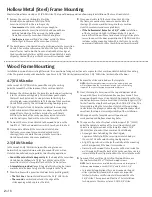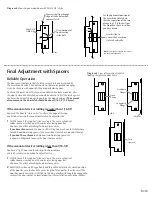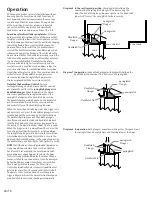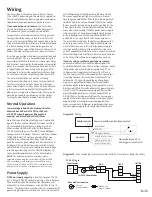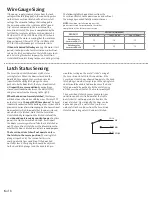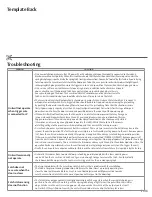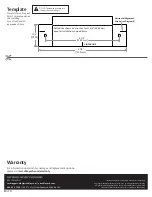
5
of 8
WHITE (STATUS: COM)
BLUE (STATUS: N.O.)
+
-
ORANGE (TRIGGER)
GREEN (STATUS: N.C.)
RED (+V)
BLACK (NEG)
UNLATCH
Power should be constantly connected
Note diode orientation:
1N5333 Zener diodes
+
NC
C
NO
NC
C
NO
+
TRG
ORG
RED
BLK
UNL-24
PB2E
BR-4
Closure bV in
and trigger releases latch
POWER SUPPLY DC
Cross bar
denotes cathode
Banded side
denotes cathode
120
VAC IN
VAC
OUT
TP-24-2 Plug In
Transformer
Wiring
The Securitron UnLatch is a six wire device. Power
(12 or 24VDC depending on the model) is applied to
the red and black wires observing polarity and power
should be continuously present on these wires.
If you connect power in reverse,
the Securitron
UnLatch will not operate but it will be damaged if
left connected for an extended period of time.
To operate the Securitron UnLatch, the trigger wire
(orange) should be connected to the red wire (+V)
via an external switch. When this connection is made,
the Securitron UnLatch will release the door and keep
it released so long as the red and orange wires are
connected. When connection between these wires is
broken, the door will be resecured (once it recloses).
In certain applications the door is released all day and
secured all night. There is no problem operating the
Securitron UnLatch in this manner (continuous duty)
but it is more common for the door to be released for
only a few seconds at a time for controlled entry. This
is typically done by connecting the orange and red
wires together from relay contacts which close from
an external card reader, digital keypad or keyswitch.
The external control device includes a timing
function which will operate the Securitron UnLatch
for a few seconds to permit each entry. Like most
conventional electric strikes, the Securitron UnLatch
is fail secure which means that it will maintain the
door in a secure position if power is lost. Entry is not
possible but people can, of course, exit by simply
turning the door handle or knob from the inside.
Normal Operation
In normal operation, the Securitron UnLatch
draws about 300 mA at 12 VDC or 200 mA
at 24 VDC when it operates (the motor is
moving) and a steady 40 mA at all times.
Note that regulated input voltage is not required to
operate the Securitron UnLatch. Full wave rectified
DC is acceptable (trans bridge rectifier).
When using a UNL-24 with a 24VAC transformer
(TP-24-2) and bridge rectifier (BR-7) two additional
components are required. These are two Zener diodes
(1N5333B, 5 watt, 3.3 volt or equivalent) that you
will find in a package separate from the hardware
pack. Because the peak voltage of a transformer and
bridge rectifier combination can be as high as forty
volts the diodes are required to drop the peak voltage
into the operable range for the UNL-24.
Diagram 10
notes installation placement of the Zener diodes.
NOTE:
The addition of the Zener diodes is only
required when using the Securitron UNL-24 with 24
VAC transformer and bridge rectifier. When using
the Securitron UNL-12 with 12 VAC transformer and
bridge rectifier the Zener diodes are not necessary.
Power Supply
DC Power supply capacity
, is ideally 3 Amps at 12 VDC
or 1.5 Amps at 24 VDC for best operation. This is because
the Securitron UnLatch’s motor (like all motors) will
momentarily draw a lot more current if it has to “work
harder”. This occurs for a very short time at motor start. If
power supply capacity is limited, the Securitron UnLatch
will still operate but it will operate a bit more slowly.
The same condition of high current draw will occur
for a longer period of time if the latch is binding which
could be a permanent condition of the latch or could
be because the person trying to enter is pulling on the
door. Again, the Securitron UnLatch will function but
more slowly and weakly. If a full capacity power supply
is not practical, a 1 Amp power supply which includes
battery backup such as Securitron’s model BPS-12-1
or BPS-24-1 is an equally effective device to power
the Securitron UnLatch as the battery will provide the
extra surge current as it is needed. Another point to
note is that when one relatively large power supply is
serving a number of Securitron UnLatches, the extra
current capability will always be there as each Securitron
UnLatch will operate at different times so each can draw
extra current from the power supply when needed.
If you are using a smaller capacity power source,
you may well be satisfied with the operation of the
Securitron UnLatch since the reduction in torque is only
really noticeable when the door is preloaded. There
is, however, an important electronic effect. During
the brief moment (100 milliseconds) while the motor
is starting to move, the Securitron UnLatch will “try”
to draw 3 or 1.5 Amps (depending on the voltage).
A power supply of lower capacity will react to this
condition by sharply dropping its voltage for the same
brief period. While this will not harm the power supply,
it may “crash” microprocessor equipped devices like
digital keypads (such as Securitron’s model DK-11 or
DK-26) that are being operated from the same power
supply. If, therefore, your installation includes a digital
keypad, or other microprocessor equipped device,
make sure you have full power supply capacity or use a
separate power supply for the keypad or other device.
Diagram 9
Wiring
Diagram 10
Zener diode placement (Securitron UNL-24, Transformer, Bridge Rectifier)


